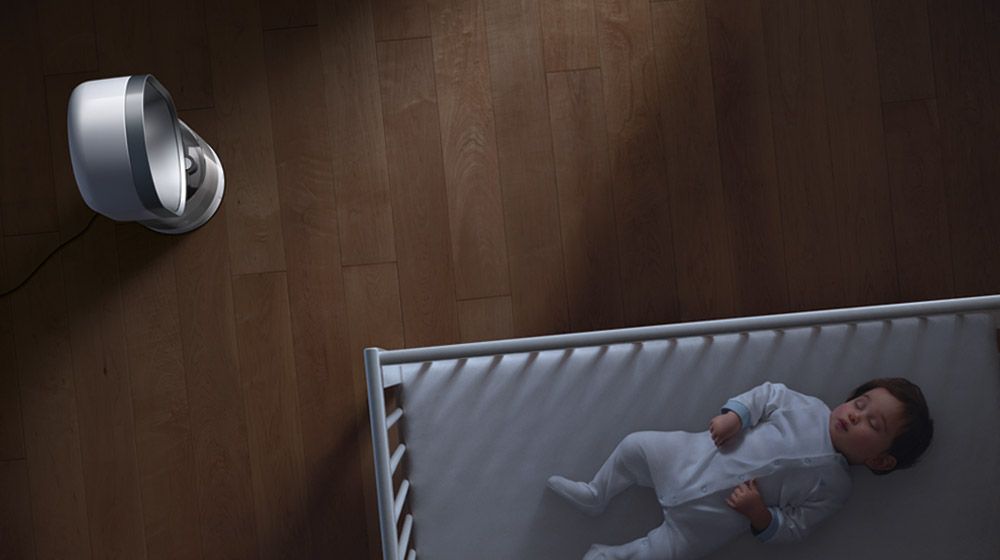
If you have allergies or recently had a baby, you’ve probably heard that getting a humidifier can do wonders. And it’s absolutely true. By putting moisture into the air, humidifiers can help with dry skin and itchy eyes, take care of sore throats and colds, lubricate sinuses and alleviate snoring. Babies are a lot more susceptible to congestion and colds than adults, which is why they tend to get sick easily in the dry, winter months. By bringing more moisture into the air, the chance of your infant battling all of the aforementioned issues lowers significantly. But of course, that’s assuming you have a good humidifier, one that actually kills bacteria in the water before it’s emitted into the atmosphere, which is where the Dyson Humidifier comes in.
“Humidifiers are sometimes seen as a way to combat allergies and the symptoms of colds and the flu—but in reality many can do quite the opposite. The majority are a breeding ground for nasty germs, which are then distributed around your home,” says James Dyson.
According to Dyson, some ultrasonic humidifiers can pump out well over 280 counts of bacteria in just two minutes, while others use a wick that can harbor germs. Dyson spent over $60.4 million to develop this machine, which took 643 prototypes and 32 test methods for the company’s scientists and engineers to get perfect. “Using patented UV light technology, the Dyson humidifier kills 99.9 percent of bacteria in the water before the machine is set to work.” Basically, every drop of water is hit with a UVC light for three minutes before released into the air. Then, “a piezoelectric transducer in the base of the machine, vibrating up to 1.7 million times a second, breaks the water down into microscopic particles, which are drawn up through the loop amplifier and projected through the air using Air Multiplier technology.”

To keep your household ideal, the humidity level should be kept between 40 and 60 percent. To avoid overdoing it, the gadget measures the temperature and pre-existing humidity in the room, adjusting its settings to create optimal levels. All of this helped it to be certified asthma and allergy friendly by the Asthma and Allergy Foundation of America, an achievement that the design went through a range of tests to be awarded.
The Dyson Humidifier looks just like their line of bladeless fans (except for the water tank of course) and can be used as one without the added mist by a press of a button on the magnetic controller. Of course, just like the Dyson Pure Cool, it is incredibly quiet (it’s actually the first humidifier to get a Quiet Mark by the Noise Abatement Society). It will disperse mist evenly in a 172-sqaure-foot room and one tank of water lasts around 18 hours of continuous use, while the built-in sleep time will shut it off whenever you want.

The assembly is incredibly easy and quick. All you have to do is fill the three-liter tank (which has a little handle for transport), slide it on the base and then snap on the top fan portion. Once it sanitizes the water and starts pumping out the mist, I recommend upping the humidity level all the way up to 70, so you can really see the mist. For regular use though, you may want to leave it on Auto so it can customize the strength as needed. Of course, with something like moisture in the air, it may take you some time to figure out what setting you like best, whether it be a little drier than what the machine recommends or fresh and cool like a pleasant rainforest (clearly I prefer the latter).

You are supposed to dismantle the device every week (or at least every month) for cleaning, using a citric acid solution. The frequency will probably depend on whether or not you’re using “hard water,” which has a high mineral content and can leave residue. Cleaning the humidifier may seem tedious, but speaking as someone who is very familiar with hard water damage in bathtubs and showers, you should really follow the directions if you aren’t sure as to the type of water you have. Plus, if you’re concerned with breathing in bacteria, you should also be concerned with cleaning the machine that keeps it from happening.

I hadn’t even thought of the humidity levels in my home before trying the $499 Dyson Humidifier and now I won’t settle for anything less. The only negative I found is that unlike their fans, the humidifier doesn’t have an oscillating option, which definitely seems like a pretty big oversight considering it does everything else the fans do. Hopefully on their next iteration, the feature will be included.










